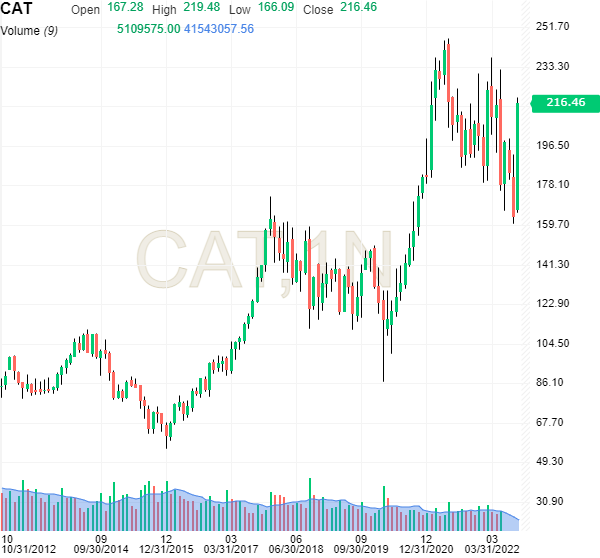Caterpillar: Why Earnings Strengthen The Long-Term Case
2022.11.01 12:17
[ad_1]
- CAT stock is coming off its best month in more than a decade
- Strong Q3 earnings capped rally — but external environment looks questionable
- For a cyclical business like Caterpillar, there’s one key question, but the answer might not be as bearish as some investors believe
Caterpillar (NYSE:) stock just closed its strongest month since 2009. In theory, that fact alone should raise some caution.
After all, CAT is one of the most cyclical large-cap stocks in the market, as its 10-year chart shows:

CAT 10-Year Chart.
Huge moves higher usually are followed by some kind of pullback.
Indeed, after CAT rallied 7.7% following strong , a pair of analysts expressed caution. UBS pointed to lower earnings multiples across the market as a reason to perhaps , as the stock was downgraded to neutral. Deutsche Bank focused on .
History suggests those analysts may be right. But even after a monster 32% rally over the past month, there’s still a strong case for further upside in Caterpillar stock.
Rising Risks
The third quarter report showed there’s nothing wrong with Caterpillar’s business at the moment. both crushed analyst expectations. Revenue increased 15% year-over-year, while adjusted earnings per share soared 48%.
But investing is about looking forward, not just backwards. And the risks to Caterpillar seem elevated, to say the least.
More than 40% of Caterpillar’s revenue comes from its Construction Industries segment. About half of those sales are in North America, where there are concerns about housing bubbles in both the U.S. and Canada. Another 20% comes from Asia-Pacific, where the appears to be in trouble.
In Energy & Transportation, investment in exploration remains somewhat constrained. The Resource Industries business in theory should be benefiting from mining demand in a period of high commodity prices. Bear in mind that it was the end of the China-led “commodity supercycle” in 2015 that helped lead Caterpillar stock to drop by almost half between 2014 and 2016.
Valuing A Cyclical Stock
The reason Caterpillar stock fell during that stretch is because Caterpillar earnings plunged. In 2014, on an adjusted basis, Caterpillar posted EPS of $6.38. Two years later, the figure was just $3.42.
The worry here is that Caterpillar earnings may follow a similar trajectory, even if profits don’t necessarily fall 46% over two years. And that worry isn’t necessarily priced in. CAT trades at 15x-16x this year’s earnings, depending on how Q4 plays out. That’s hardly a multiple that prices in a decline — or even several years of relatively stagnant growth.
Indeed, for a time in 2016 CAT stock traded at 15x-16x earnings — and that was at a cyclical bottom, when, in theory, multiples should expand. Closer to a top, the multiple should be lower.
It’s that fundamental concern that explains Wall Street’s response to the report. Yes, the business is performing well, but for cyclical stocks strong performance carries its own inherent risk.
The Case For CAT
But there’s one potential reason for seeing cyclical worries as overblown: The fact that the external environment is not quite as positive as might be believed.
It’s true that demand is strong. That said, Caterpillar has plenty of other headwinds at the moment. Its supply chain remains relatively snarled. Chief executive officer Jim Umpleby said on the Q3 call that revenue in the quarter would have been even higher had the company been able to serve all of its demand. Backlog now is at $30 billion, or more than six months’ worth of sales, suggesting a cyclical downturn isn’t imminent in the near future.
Costs have been elevated, both by supply-chain issues and by broader inflation. Labor shortages have impacted, not just Caterpillar itself, but its end customers, who haven’t always been able to move forward on major projects.
This simply isn’t a standard macro cycle. It’s been accompanied by real challenges that actually have been a drag on revenue and profit margins.
In that context, the valuation here perhaps is not quite as onerous as skeptics might suggest. And it’s worth considering the longer-term landscape as well.
Demand for Caterpillar equipment is going to see some cyclical impacts — but by all accounts it should continue to rise. Growth in electric vehicles will require enormous amounts of mineral exploration. That aside, both miners and wildcatters have been relatively light in investing behind exploration of late.
Whether that’s a result of political pressure or shareholder demands is up for debate, but whatever the cause this — again — is not a typical cyclical upswing.
Over time, this seems like a business that is going to grow. Meanwhile, results this year — in which Caterpillar showed it could pass along costs and then some — suggest the company’s competitive position is rock-solid.
In a normal cyclical upswing, the results Caterpillar is posting right suggest a reversal is due. In this environment, however, that isn’t necessarily the case. In the former scenario, 16x earnings probably is too much to pay. In the latter, it’s probably too little.
Disclaimer: As of this writing, Vince Martin has no positions in any securities mentioned.
[ad_2]
Source link








